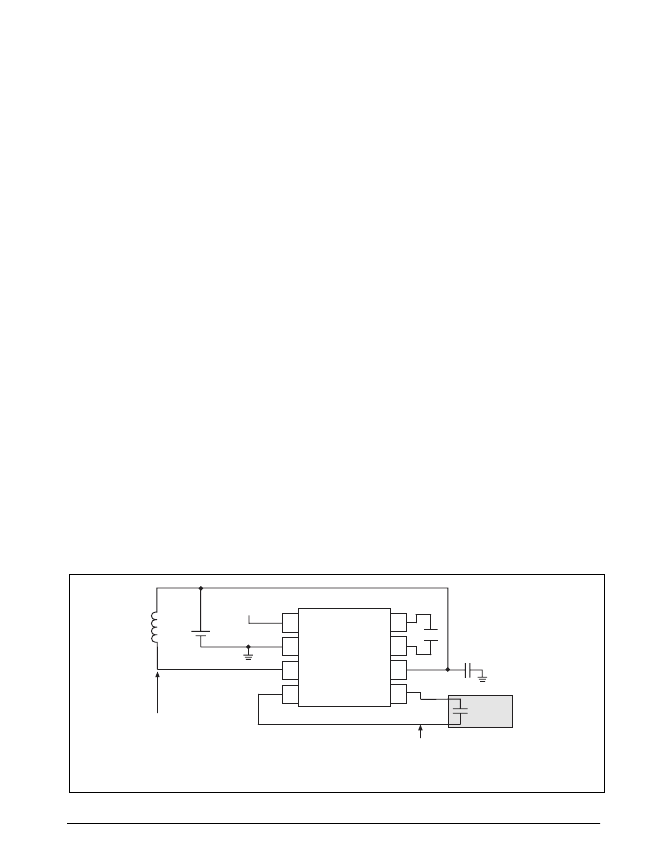- 您現(xiàn)在的位置:買賣IC網(wǎng) > PDF目錄372182 > SP4422ANEB Circular Connector; No. of Contacts:55; Series:MS27508; Body Material:Aluminum; Connecting Termination:Crimp; Connector Shell Size:16; Circular Contact Gender:Pin; Circular Shell Style:Box Mount Receptacle; Insert Arrangement:16-55 RoHS Compliant: No PDF資料下載
參數(shù)資料
| 型號: | SP4422ANEB |
| 元件分類: | 圓形連接器 |
| 英文描述: | Circular Connector; No. of Contacts:55; Series:MS27508; Body Material:Aluminum; Connecting Termination:Crimp; Connector Shell Size:16; Circular Contact Gender:Pin; Circular Shell Style:Box Mount Receptacle; Insert Arrangement:16-55 RoHS Compliant: No |
| 中文描述: | 電致發(fā)光燈驅(qū)動(dòng)器 |
| 文件頁數(shù): | 4/13頁 |
| 文件大?。?/td> | 136K |
| 代理商: | SP4422ANEB |

SP4422ADS/15
SP4422A Electroluminescent Lamp Driver
4
Copyright 2000 Sipex Corporation
clock source to pin 8. The clock should have a 50%
duty cycle and range fromV
-1V to ground. An
external clock signal may be desirable in order to
synchronize any parasitic switching noise with the
system clock. The maximum external clock
frequency that can be supplied is 400kHz.
The coil is an external component connected from
V
to pin 3 of the
SP4422A
. Energy is stored
in the coil according to the equation E
=1/2LI
2
,
where I is the peak current flowing in the inductor.
The current in the inductor is time dependent and
is set by the "ON" time of the coil switch: I=(V
L
/
L)t
, where V
is the voltage across the inductor.
At the moment the switch closes, the current in the
inductor is zero and the entire supply voltage
(minus the V
of the switch) is across the inductor.
The current in the inductor will then ramp up at a
linear rate. As the current in the inductor builds up,
the voltage across the inductor will decrease due to
the resistance of the coil and the "ON" resistance
of the switch: V
=V
-IR
-V
. Since the
voltage across the inductor is decreasing, the current
ramp-rate also decreases which reduces the current
in the coil at the end of t
the energy stored in the
inductor per coil cycle and therefore the light
output. The other important issue is that maximum
current (saturation current) in the coil is set by the
design and manufacturer of the coil. If the
parameters of the application such as V
, L,
RL or ton cause the current in the coil to increase
beyond its rated I
, excessive heat will be
generated and the power efficiency will decrease
with no additional light output. The
Sipex
SP4422A
is final tested using a 5mH/18
coil from Hitachi
Metals. For suggested coil sources see
page 10
.
Typical SP4422A Application Circuit
The supply V
can range from 2.2 to 5.0V. It is not
necessary that V
= V
. V
should not
exceed max coil current specification. The majority
of the current goes through the coil and is typically
much greater than I
DD
.
The f
signal controls a switch that connects the
end of the coil at pin 3 to ground or to open circuit.
The f
signal is a 94% duty cycle signal switching
at 1/8 the oscillator frequency. For a 64kHz
oscillator f
is 8kHz. During the time when the
f
COIL
signal is high, the coil is connected from
V
to ground and a charged magnetic field is
created in the coil. During the low part of f
, the
ground connection is switched open, the field
collapses and the energy in the inductor is forced
to flow toward the high voltage H-bridge
switches. f
will send 16 of these charge pulses
(see
figure 2
on
page 9
) to the lamp, each pulse
increases the voltage drop across the lamp in
discrete steps. As the voltage potential approaches
its maximum, the steps become smaller (see
figure
1
on
page 9
).
The H-bridge consists of two SCR structures that
act as high voltage switches. These two switches
control the polarity of how the lamp is charged.
The SCR switches are controlled by the f
signal which is the oscillator frequency divided by
256. For a 64kHz oscillator, f
LAMP
=256Hz.
0.1
μ
F Low ESR
Decoupling
Capacitor
EL Lamp
NOTE:
Keep high voltage traces
short and away from V
DD
and clock lines
Cap2
Cap1
V
DD
EL1
HON
V
SS
Coil
EL2
HON=V
=ON
HON=0V=OFF
SP4422A
V
IN
=3V
9
NOTE:
Keep coil as close to the
SP4422A as possible
+
–
C
OSC
=100pF
相關(guān)PDF資料 |
PDF描述 |
|---|---|
| SP4422AUEB | ER 14C 12#16 2#4 SKT RECP BOX RoHS Compliant: No |
| SP4422A | High Voltage Output Electroluminescent Lamp Driver(高壓輸出,場致發(fā)光燈驅(qū)動(dòng)器) |
| SP4422 | Electroluminescent Lamp Driver |
| SP4422ACN | Electroluminescent Lamp Driver |
| SP4422ACU | Electroluminescent Lamp Driver |
相關(guān)代理商/技術(shù)參數(shù) |
參數(shù)描述 |
|---|---|
| SP4422AUEB | 制造商:SIPEX 制造商全稱:Sipex Corporation 功能描述:Electroluminescent Lamp Driver |
| SP4423 | 制造商:SIPEX 制造商全稱:Sipex Corporation 功能描述:Electroluminescent Lamp Driver Low Power Applications |
| SP4423CN | 制造商:Exar Corporation 功能描述:BALLAST/BACKLIGHT CONTROLLER/DRIVER, 8 Pin, Plastic, SOP |
| SP4423CU | 制造商:Exar Corporation 功能描述:BALLAST/BACKLIGHT CONTROLLER/DRIVER, 8 Pin, Plastic, TSSOP |
| SP4423CX | 制造商:SIPEX 制造商全稱:Sipex Corporation 功能描述:Electroluminescent Lamp Driver Low Power Applications |
發(fā)布緊急采購,3分鐘左右您將得到回復(fù)。